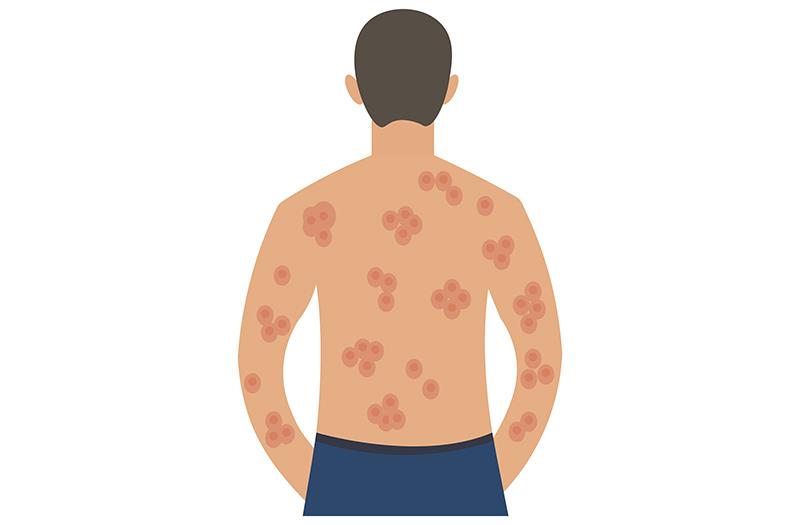Hidradenitis suppurativa patients get durable benefit with bimekizumab





The interleukin-17 (IL-17) blocker bimekizumab delivers sustained clinical benefits lasting up to 2 years for patients with moderate-to-severe hidradenitis suppurativa (HS), as reported in a late-breaking presentation at EADV 2024.
Two-year bimekizumab data from the phase III BE HEARD I/II trials and the open-label BE HEARD EXT extension study showed that the clinically meaningful improvements in efficacy endpoints at 1 year (week 48) were maintained over 2 years (week 96), according to lead investigator Dr Christos Zouboulis, president of the European Hidradenitis Suppurativa Foundation (EHSF) e.V. in Dessau, Germany.
The proportion of patients who achieved a 50-percent improvement in baseline lesions (HS Clinical Response 50 [HiSCR50]) slightly increased from 79.9 percent at week 48 to 85.4 percent at week 96. A similar pattern of increase was seen for the more stringent endpoints of 75-percent improvement (HiSCR75: from 64.0 percent to 77.1 percent), 90-percent improvement (HiSCR90: from 42.3 percent to 57.6 percent), and 100-percent improvement (HiSCR100: from 30.2 percent to 44.2 percent). [EADV 2024, abstract 7925]
A step-down in disease severity
The mean International Hidradenitis Suppurativa Severity Scoring System (IHS4) score dropped from 35.6 at baseline to 7.2 at week 98, for a mean percentage change of –79.8 percent. This represents a significant decrease in disease severity, moving patients from the severe range (total score of 11 or higher) to the moderate range (total score of 4–10), Zouboulis pointed out.
He described the IHS4 data as a landmark achievement, noting that until now, surgical interventions were the primary means of achieving a step-down in disease severity. “Now we have a drug that can dial back the severity of HS. It’s very promising.”
Additionally, the draining tunnel count decreased by 73.7 percent at week 96, from a mean of 3.8 at baseline to 1.1. When multiplied by 4.4, the reduction in draining tunnel count translates to an estimated IHS4 score that demonstrates a step-down in the range of HS severity over 2 years, Zouboulis explained. [Br J Dermatol 2017;177:1401-1409]
Improved quality of life
The mean Dermatology Life Quality Index (DLQI) score decreased from 11.0 at baseline to 4.7 at week 96, with 33.9 percent of patients achieving a DLQI score of 0/1.
Zouboulis emphasized that unlike previous studies with adalimumab, where patients often reported needing a year to feel the full benefits, with bimekizumab, patients began noticing improvements within the first 8 weeks of treatment, with a substantial number achieving a DLQI score of 0/1, which essentially indicates the absence of disease for patients.
No new safety events
“No new safety signals were observed with bimekizumab, and the safety profile over 2 years was consistent with findings from BE HEARD I/II and studies of bimekizumab in other indications,” Zouboulis said.
At week 96, the exposure adjusted incidence rates per 100 person-years were 248.9 for any treatment- emergent adverse events (TEAEs), 7.2 for serious TEAEs, 7.7 for severe TEAEs, and 6.3 for TEAEs leading to treatment discontinuation. The most common TEAEs were hidradenitis, coronavirus infection, and mild-to-moderate oral candidiasis. Two patients died, one due to congestive heart failure and another due to possible central nervous system infection in the context of deteriorating HS.
Taken together, “these data highlight the durability and consistency of bimekizumab treatment in patients with moderate-to-severe HS,” Zouboulis said.
“HS is such a very difficult disease, and it’s gratifying to witness the emergence of a new treatment that delivers satisfactory results for the patients,” he added.
BE HEARD population
The current analysis included 556 patients (mean age 36.3 years, 53.8 percent female, 80.6 percent White, mean BMI 32.5 kg/m2) who completed 48 weeks of bimekizumab treatment in BE HEARD I/II and entered the BE HEARD EXT. Of these, 446 patients completed the open-label extension phase.
In BE HEARD I/II, patients were randomly assigned to receive one of following treatments: (1) subcutaneous bimekizumab 320 mg every 2 weeks; (2) bimekizumab 320 mg every 2 weeks to week 16, then every 4 weeks through week 48; (3) bimekizumab 320 mg every 4 weeks; (4) placebo to week 16, then bimekizumab 320 mg every 2 weeks through week 48.
In BE HEARD EXT, patients who achieved HiSCR90 response or higher at week 48 received bimekizumab 320 mg every 4 weeks through week 96, while those who had a response lower than HiSCR90 received bimekizumab 320 mg every 2 weeks.